
1997, meter stamp from the secondary school, Colegio Immaculada - Jesuitas in Alicante
JESUIT
INSTITUTIONS |
Colegio
Immaculada, Alicante

1997, meter stamp from the secondary school, Colegio
Immaculada - Jesuitas in Alicante
The Archdeacon's House, Barcelona


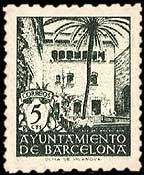
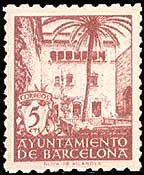
SPAIN (the City Council of Barcelona), 1 January 1945

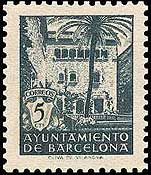
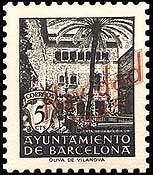
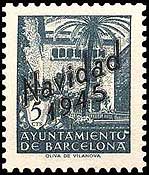
SPAIN (the City Council of Barcelona), 26 January and 1 December 1945
These last two were issued in mini-sheets of 4
and were overprinted for Christmas 1945 and also issued in mini-sheets of 4
In 1875 Jesuits began to return to Spain from exile, setting themselves up in different cities. By 1877 there were three small Jesuit communities in Barcelona. The following year they found space to unite in one community the Jesuits who were scattered throughout the city. It was at the Archdeacon's House (Casa de l'Ardiaca) in front of the cathedral. Nine priests and six brothers moved there together, with the intention of eventually setting up a Jesuit college in Barcelona, the Collegi Casp–Sagrat Cor de Jesús founded in 1881. In 1895, the Archdeacon's House became the home of the Lawyers' Association. Visitors today will remember the mail box set at the front door by the modernist architect Lluís Domènech i Muntaner (1902): a pigeon on it represents the hope for quick mail delivery, a tortoise represents the reality.
Collegi
Sant Ignasi-Sarrià, Barcelona

1992, meter stamp for the College
of St. Ignatius in Barcelona
Institut
Quimic de Sarria, Barcelona

2001, meter stamp for the Institut
Quimic de Sarria, Universidad
Ramon Llull, Barcelona,
founded in 1905 by Fr. Eduardo Vitoria, SJ in Roquetes (Tarragona) as the Laboratorio
Químico del Ebro

SPAIN, 1987, the centenary of the University of
Deusto, Scott 2510
The University of Deusto in the region of Bilbao was entrusted to the Jesuits from its beginning. The university now has more than 15,000 students, 8 schools, 5 institutes, 6 university schools and campuses at San Sebastian and Bibao. Its Business School, the first in Spain, dates from 1916.

1962, 75th anniversary of the University
of Deusto
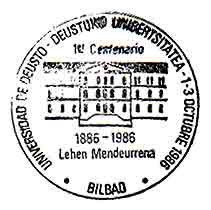

1986, centenary of the Univesity of Deusto
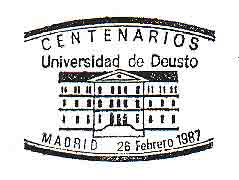
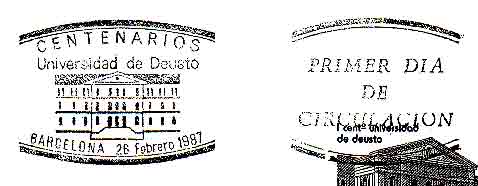
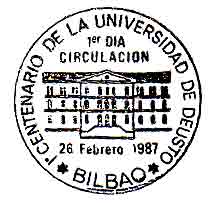
1987, FDI cancels for Scott 2510
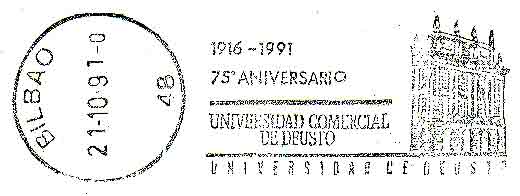
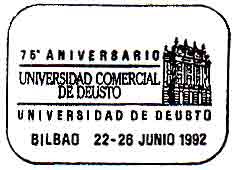
1991-1992, 75th anniversary of the Business School




Meter stamps with different slogans
Colegio de la Inmaculada PP. Jesuitas, Gijón, Asturias

1991, meter stamp for the Colegio
de la Inmaculada PP. Jesuitas, Gijón, Asturias
The Jesuit Church and College, Graus

SPAIN, 2001, show cancel for the 4th centenary of the birth of Fr. Balthasar
Gracian, SJ,
which shows the Jesuit church and residence where he lived in Graus
The Jesuit college and church in Graus was founded in February 1651 thanks to the generosity of Bishop Esteban de Esmir, a native of Graus, rector of the University of Lérida and Bishop of Huesca. This was the most northern college of the Jesuit province of Aragon. It was the mainstay of the educational and cultural development of this region until the Suppression in 1773. The church, dedicated to St. Francis Xavier, is modeled on the Church of the Gesú of Rome and seems to have been consecrated in 1722. The image of the saint is carved into the cornice over the main entrance. The square before the buildings was renamed La Plaza de la Compañía.The Jesuits returned to Graus from about 1815 until 1820 when they were expelled again. They returned between 1868 and 1873, but were forced to leave once more. The buildings were confiscated by a government act of 1835, and went downhill from there. The City Council continued using the school. The church was returned as a worship space in 1919, but in the 1970s, the church closed and the school was dismantled. The buildings have since been renovated and opened its doors in December 2006 as Espacio Pirineos: Centro de Cultura, Investigación y Ocio del Pirineo.
Fr. Balthasar Gracian, SJ visited Graus in November of 1652 with his friend, Bishop Esteban de Esmir in a pastoral visit to those affected by the plague. He was later sent there, as into exile, as part of punishment for his unauthorized publications.
Instituto Padre Suarez, Grenada
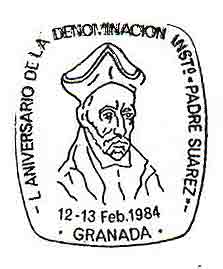

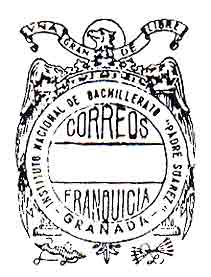
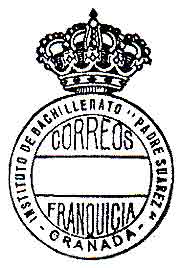
Special cancels for anniversaries of the Padre
Suarez Institute in Granada.
The Instituto Padre Suarez (Museo de Ciencias Naturales) in Granada is named for Fr. Francis Suarez, SJ (1548-1617), one of the great Spanish theologians and Jesuit thinkers of his age. His written work runs to 23 volumes. His wrestling with the moral and legal problems of colonization offered a basis for international law and an encouragement for South America independence movements.

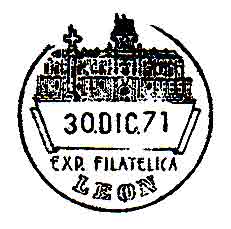
SPAIN, 1971, Scott 1653
SPAIN, 1971, show cancel featuring the Hostal San Marcos de León
Hostal San Marcos de León was a monastery-hospital founded in the twelfth century to provide shelter for the poor and for pilgrims on their way to Compostela. The building was demolished and reconstructed starting in 1515. It is now a five star hotel and presumably houses the poor no longer. The government gave it to the Jesuits in 1859 as a house of studies for overseas missionaries — not for long. The Jesuits were expelled after the "glorious" revolution of 1868.
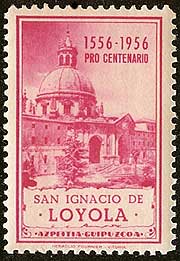
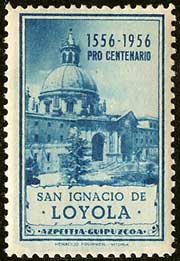
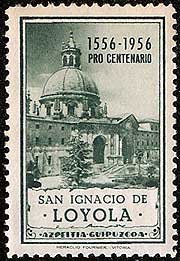
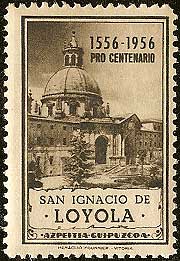
SPAIN, 1956, cinderellas featuring the domed basilica of St. Ignatius
at the Sanctuary of Loyola
The stamp was printed by Heraclio Fournier, SA, in Vitoria,
the Basque Country, Spain in each of the four colors shown.


SPAIN, 1955, 4th century of the death
of Ignatius showing his casa torre at the Sanctuary, Scott 837
1991, 5th centenary of Ignatius' birth showing the Sanctuary building, Scott
2653
St. Ignatius' ancient casa torre at Loyola is now totally surrounded by the building of the Sanctuary at Loyola, a retreat house and Jesuit center. The sanctuary with its domed basilica of St. Ignatius appears in the distance on a more recent stamp and can been seen even more clearly on the Spanish cinderellas — printed to celebrate Ignatius' 4th centenary and showing the dome of the basilica of St. Ignatius at the Sanctuary.